Time Stable Reduced Order Modeling by an Enhanced Reduced Order Basis of the Turbulent and Incompressible 3D Navier–Stokes Equations
Abstract
:1. Introduction
2. Theoretical Framework
2.1. POD-Galerkin Reduced Order Modeling Applied to the Unsteady and Incompressible Navier–Stokes Equations
2.2. Physical Stabilization by Satisfying the Kinetic Energy Budget
2.2.1. Enrichment of the POD-Galerkin ROM with the Flow Rate Driving Forces
2.2.2. Enrichment of the POD-Galerkin ROM with the Most Dissipative Scales Based on the Velocity Gradient
- Compute the POD velocity modes and truncate at these POD modes. We note that N is intentionally chosen to be less than the needed number of the POD modes to represent all the features of the coherent energetic scales of the kinetic energy.
- Compute the fluctuating POD gradient modes and truncate at . Where for , a set of orthonormal eigenvectors of the temporal correlations matrix on the fluctuating velocity gradient: (W the mean velocity gradient being removed from these correlations), and is the sequence of the eigenvalues of this latter matrix.
- Compute the following velocity basis functions: .
- Perform the Gram–Schmidt orthonormalization process for the enriched set with respect to the energy-based inner product . This step is the key of the enforcement of dissipative energy modes with high singular values in early ranks of the reduced order basis, which is the opposite case when considering only the classical velocity-based POD modes (dissipative energy modes are classified respectively with very small singular values).
3. Application of the Stabilization Approach to a Typical Aeronautical Injector
3.1. Flow Solver
3.2. Typical Aeronautical Injector of Re = 45,000 Lean Preccinsta Burner
3.2.1. Test Case Presentation
3.2.2. POD Modes Computation for the Preccinsta
3.2.3. The Enhanced Reduced Order Basis
- We choose and start the enforcement by the new velocity modes from the 5th rank. This choice is made because we want to limit the number of classical global POD modes which do not exhibit at the end very large features of spatial scales, as we can see on the modes , and .
- We choose because, as already discussed, we need a large number of velocity gradient-based POD modes in order to reproduce of the small and dissipatives scales of the TKE as shown on Figure 19.
- We perform the Gram–Schmidt orthonormalization process for the enriched set with respect to the energy-based inner product .
- We recall that the choice is done intentionally in order to retrieve some dissipative modes at earlier stages than in the classical POD technique where we can see that even after 12 modes we do not have any modes of large scale’s features.
- The fact that the dissipative energy modes appear at late stages in the classical POD technique with very small singular values is the reason why we are not able to exploit their physical significance even if we increase the dimension of the classical POD reduced order model.
- We add starting velocity-based modes of high singular values and large features of scales.
- This enrichment by small scale enforcement and separation is the key to multi-scale reproduction within the reduced order modeling. We precise once more that this approach is very different than the ones based on the change of the inner product that defines the matrix of the correlations between the instanteneous snapshots, typically the approach where the inner product is considered instead of the inner product. By our approach we enable scale separation, then small scale’s enforcement, which is very hard to distinguish when performing a correlations matrix and then retrieving a complete POD basis: the small scales will remain dominated by the correlated large scales even if we perform this inner product change. Some authors use mathematical calibration in order to retrieve the small scales [17].
3.2.4. The Temporal Coefficients and Kinetic Energy of the Enriched Reduced Order Model and the Comparaison with the Classical POD-Galerkin Reduced Order Model
3.2.5. 3D Time Fields Obtained by the ROM and the High-Fidelity Model
3.2.6. CPU Time for Offline and Online Computation
4. Temporal Extrapolation of the Dissipative ROM
5. Conclusions and Prospects
Author Contributions
Conflicts of Interest
Abbreviations
| ROM | Reduced order modeling |
| POD | Proper orthogonal decomposition |
| PVC | Precessing vortex core |
| SVD | Singular value decomposition |
| HF | High-fidelity |
| LES | Large eddy simulation |
| FTT | Flow through time |
| TKE | Turbulent kinetic energy |
References
- Couplet, M.; Sagaut, P.; Basdevant, C. Intermodal energy transfers in a proper orthogonal decomposition-Galerkin representation of a turbulent separated flow. J. Fluid Mech. 2003, 491, 275–284. [Google Scholar] [CrossRef]
- Rowley, C.; Colonius, T.; Murray, R. Model Reduction for compressible flows using POD and Galerkin projection. Phys. D Nonlinear Phenom. 2004, 189, 115–129. [Google Scholar] [CrossRef]
- Baiges, J.; Codina, R.; Idelsohn, S. Reduced-order subscales for POD models. Comput. Methods Appl. Mech. Eng. 2015, 291, 173–196. [Google Scholar] [CrossRef]
- Balajewicz, M.; Tezaur, I.; Dowell, E. Minimal subspace rotation on the Stiefel manifold for stabilization and enhancement of projection-based reduced order models for the incompressible Navier–Stokes equations. J. Comput. Phys. 2016. [Google Scholar] [CrossRef]
- Xie, X.; Wells, D.; Wang, Z.; Iliescu, T. Approximate Deconvolution Reduced Order Modeling. Comput. Methods Appl. Mech. Eng. 2017, 313, 512–534. [Google Scholar] [CrossRef]
- Mohebujjaman, M.; Rebholz, L.G.; Xie, X.; Iliescu, T. Energy balance and mass conservation in reduced order models of fluid flows. J. Comput. Phys. 2017, 346, 262–277. [Google Scholar] [CrossRef]
- McLaughlen, B.; Peterson, J.; Ye, M. Stabilized reduced order models for the advection-diffusion-reaction equation using operator splitting. Comput. Math. Appl. 2016, 71, 2407–2420. [Google Scholar] [CrossRef]
- Carlberg, K.; Choi, Y.; Sargsyan, S. Conservative model reduction for finite-volume models. J. Comput. Phys. 2017, 371, 280–314. [Google Scholar] [CrossRef]
- Stabile, G.; Hijazi, S.; Mola, A.; Lorenzi, S.; Rozza, G. POD-Galerkin reduced order methods for CFD using Finite Volume Discretisation: Vortex shedding around a circular cylinder. Commun. Appl. Ind. Math. 2017, 8, 210–236. [Google Scholar] [CrossRef]
- Stabile, G.; Rozza, G. Finite volume POD-Galerkin stabilized reduced order methods for the parametrised incompressible Navier–Stokes equations. Comput. Fluids 2018, 173, 273–284. [Google Scholar] [CrossRef]
- Amsallem, D.; Farhat, C. On the Stability of Reduced-Order Linearized Computational Fluid Dynamics Models Based on POD and Galerkin Projection: Descriptor vs Non-Descriptor Forms. In Reduced Order Methods for Modeling and Computational Reduction; Quarteroni, A., Rozza, G., Eds.; Springer International Publishing: Cham, Switzerland, 2014; pp. 215–233. [Google Scholar]
- Akhtar, I.; Nayfeh, A.H.; Ribbens, C.J. On the stability and extension of reduced-order Galerkin models in incompressible flows. Theor. Comput. Fluid Dyn. 2009, 23, 213–237. [Google Scholar] [CrossRef]
- Amsallem, D.; Farhat, C. Stabilization of projection-based reduced-order models. Int. J. Numer. Methods Eng. 2012, 91, 358–377. [Google Scholar] [CrossRef]
- Wang, Q.; Jan, S.H.; Ray, D. Non-intrusive reduced order modeling of unsteady flows using artificial neural networks with application to a combustion problem. J. Comput. Phys. 2019, 384, 289–307. [Google Scholar] [CrossRef]
- Lapeyre, C.J.; Misdariis, A.; Casard, N.; Veynant, D.; Poinsot, T. Training convolutional neural networks to estimate turbulent sub-grid scale reaction rates. Combust. Flame 2019, 203, 255–264. [Google Scholar] [CrossRef]
- Xie, X.; Zhang, G.; Webster, C.G. Data Driven Reduced Order Modeling of Fluid Dynamics Using Linear Multistep Network. arXiv 2018, arXiv:1809.07820. [Google Scholar]
- Iollo, A.; Lanteri, S.; Desideri, J. Stability properties of POD–Galerkin approximations for the compressible Navier–Stokes equations. Theor. Comput. Fluid Dyn. 2000, 13, 377–396. [Google Scholar] [CrossRef]
- Guedot, L.; Lartigue, G.; Moureau, V. Numerical study of spray/precessing vortex core interaction in realistic swirling flows. In Proceedings of the 10th International ERCOFTAC Symposium on Engineering Turbulence Modelling and Measurements, Marbella, Spain, 17–19 September 2014. [Google Scholar]
- Sirovich, L. Turbulence and the dynamics of coherent structures. III. Dynamics and scaling. Q. Appl. Math. 1987, 45, 583–590. [Google Scholar] [CrossRef]
- Akkari, N.; Mercier, R.; Moureau, V. Geometrical Reduced Order Modeling (ROM) by Proper Orthogonal Decomposition (POD) for the incompressible Navier Stokes equations. In Proceedings of the 2018 AIAA Aerospace Sciences Meeting, Kissimmee, FL, USA, 8–12 January 2018. [Google Scholar]
- Moureau, V.; Domingo, P.; Vervisch, L. Design of a massively parallel CFD code for complex geometries. Comptes Rendus Mécanique 2011, 339, 141–148. [Google Scholar] [CrossRef]
- Moureau, V.; Domingo, P.; Vervisch, L. From Large-Eddy Simulation to Direct Numerical Simulation of a Lean Premixed Swirl Flame: Filtered Laminar Flame-PDF Modeling. Combust. Flame 2011, 158, 1340–1357. [Google Scholar] [CrossRef]
- Malandain, M.; Maheu, N.; Moureau, V. Optimization of the deflated conjugate gradient algorithm for the solving of elliptic equations on massively parallel machines. J. Comput. Phys. 2013, 238, 32–47. [Google Scholar] [CrossRef]
- Meier, W.; Weigand, P.; Duan, X.R.; Giezendanner-Thoben, R. Detailed characterization of the dynamics of thermoacoustic pulsations in a lean premixed swirl flame. Combust. Flame 2007, 150, 2–26. [Google Scholar] [CrossRef]
- Weigand, P.; Duan, X.R.; Meier, W.; Meier, U.; Aigner, M.; Bérat, C. Experimental Investigations of an Oscillating Lean Premixed CH4/Air Swirl Flame in a Gas Turbine Model Combustor. In Proceedings of the European Combustion Meeting, Louvain-la-Neuve, Belgium, 3–6 April 2005; p. 235. [Google Scholar]
- Lartigue, G.; Meier, U.; Berat, C. Experimental and numerical investigation of self-excited combustion oscillations in a scaled gas turbine combustor. Appl. Therm. Eng. 2004, 24, 1583–1592. [Google Scholar] [CrossRef]
- Roux, S.; Lartigue, G.; Poinsot, T.; Meier, U.; Bérat, C. Studies of mean and unsteady flow in a swirled combustor using experiments, acoustic analysis, and large eddy simulations. Combust. Flame 2005, 141, 40–54. [Google Scholar] [CrossRef]
- Moureau, V.; Minot, P.; Pitsch, H.; Bérat, C. A ghost-fluid method for large-eddy simulations of premixed combustion in complex geometries. J. Comput. Phys. 2007, 221, 600–614. [Google Scholar] [CrossRef]
- Fiorina, B.; Vicquelin, R.; Auzillon, P.; Darabiha, N.; Gicquel, O.; Veynante, D. A filtered tabulated chemistry model for LES of premixed combustion. Combust. Flame 2010, 157, 465–475. [Google Scholar] [CrossRef]
- Franzelli, B.; Riber, E.; Gicquel, L.Y.M.; Poinsot, T. Large Eddy Simulation of Combustion Instabilities in a Lean Partially Premixed Swirled Flame. Combust. Flame 2012, 159, 621–637. [Google Scholar] [CrossRef]
- Lourier, J.M.; Stöhr, M.; Noll, B.; Werner, S.; Fiolitakis, A. Scale Adaptive Simulation of a thermoacoustic instability in a partially premixed lean swirl combustor. Combust. Flame 2017, 183, 343–357. [Google Scholar] [CrossRef]




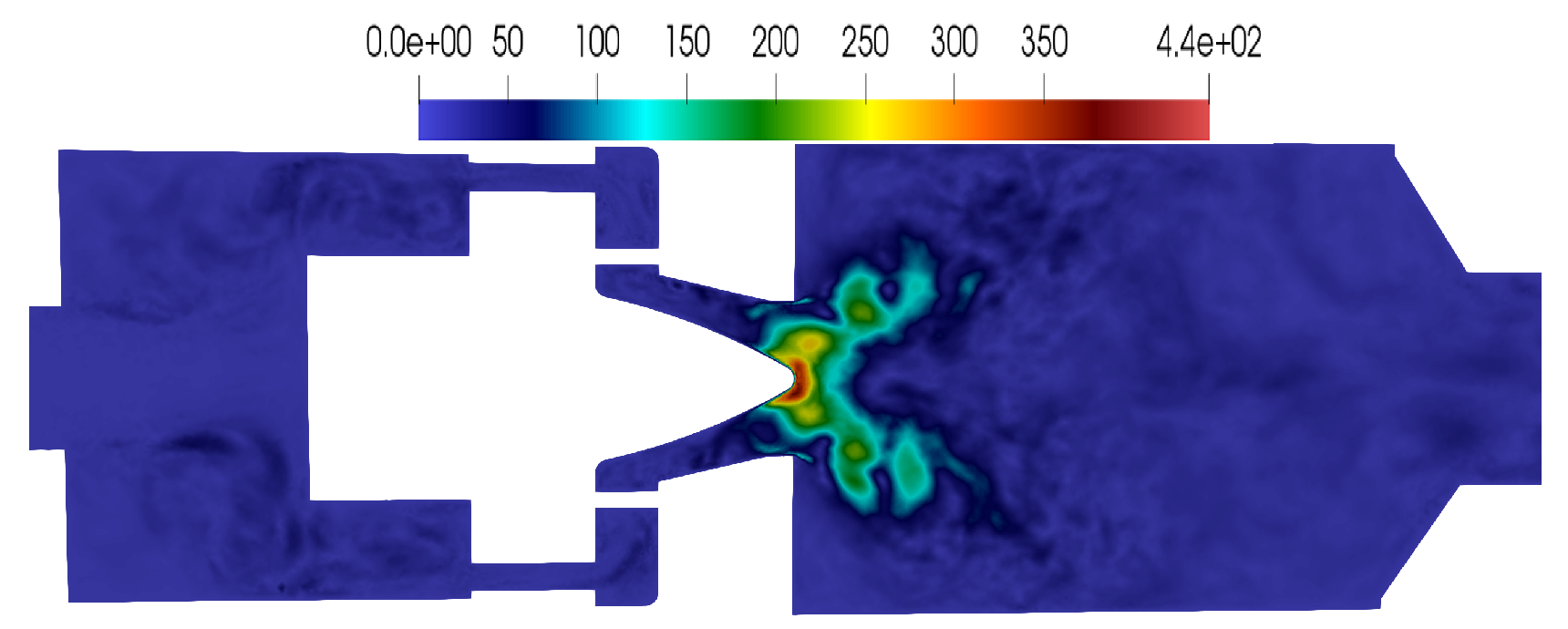


















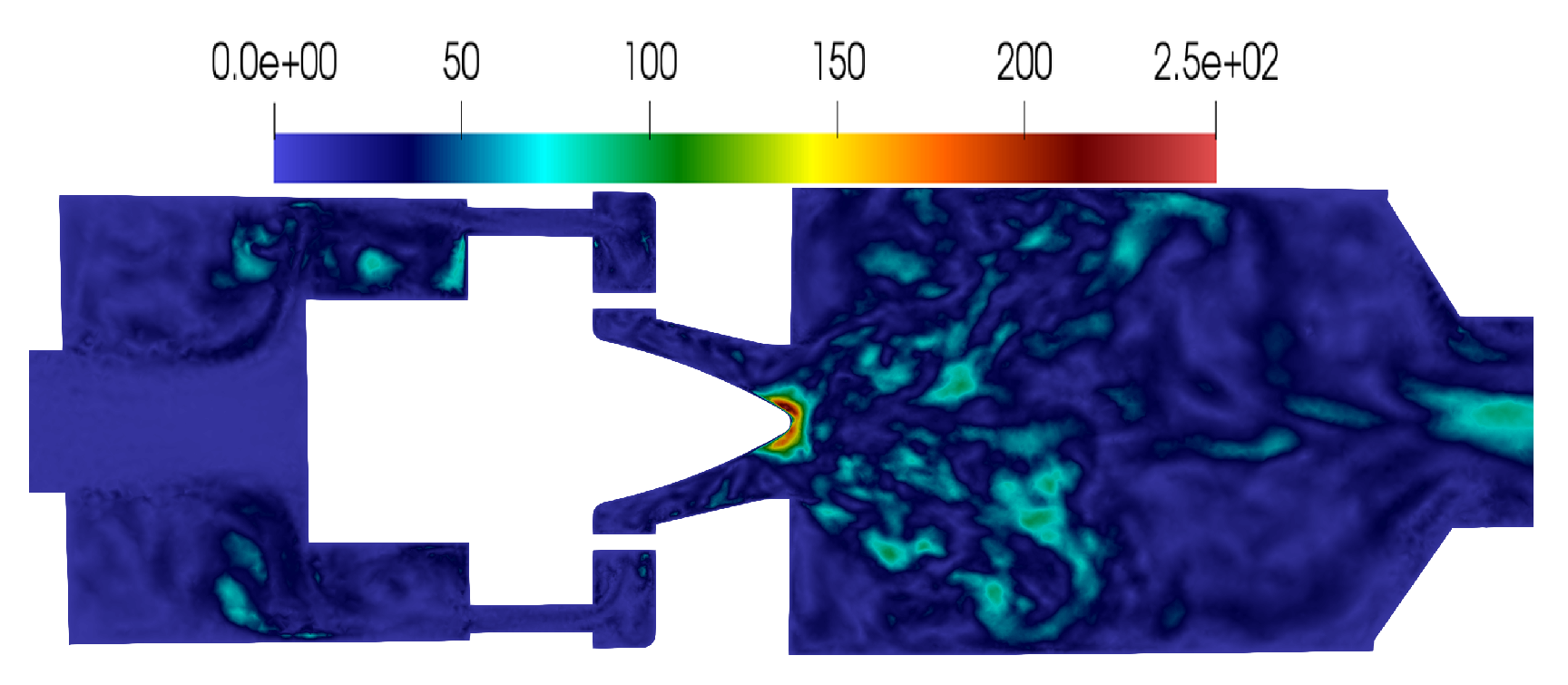
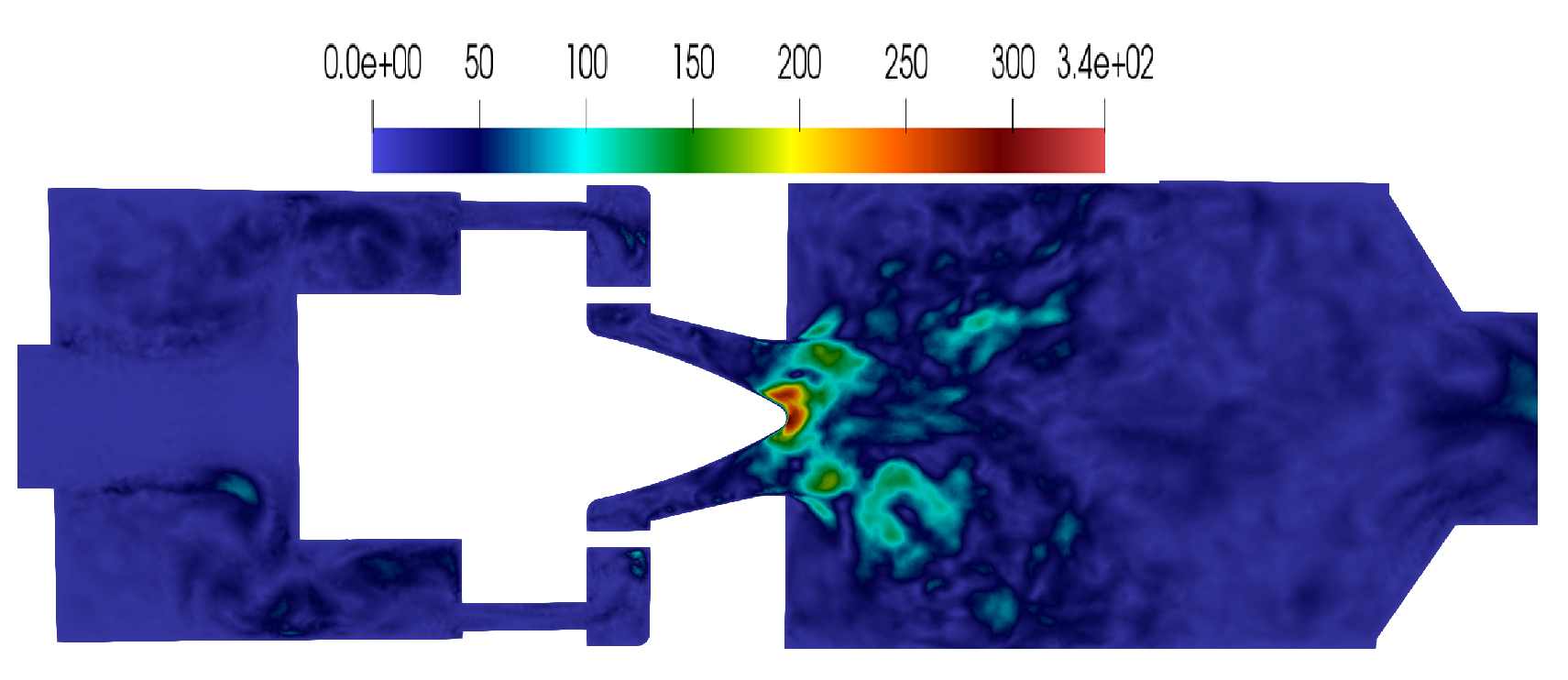













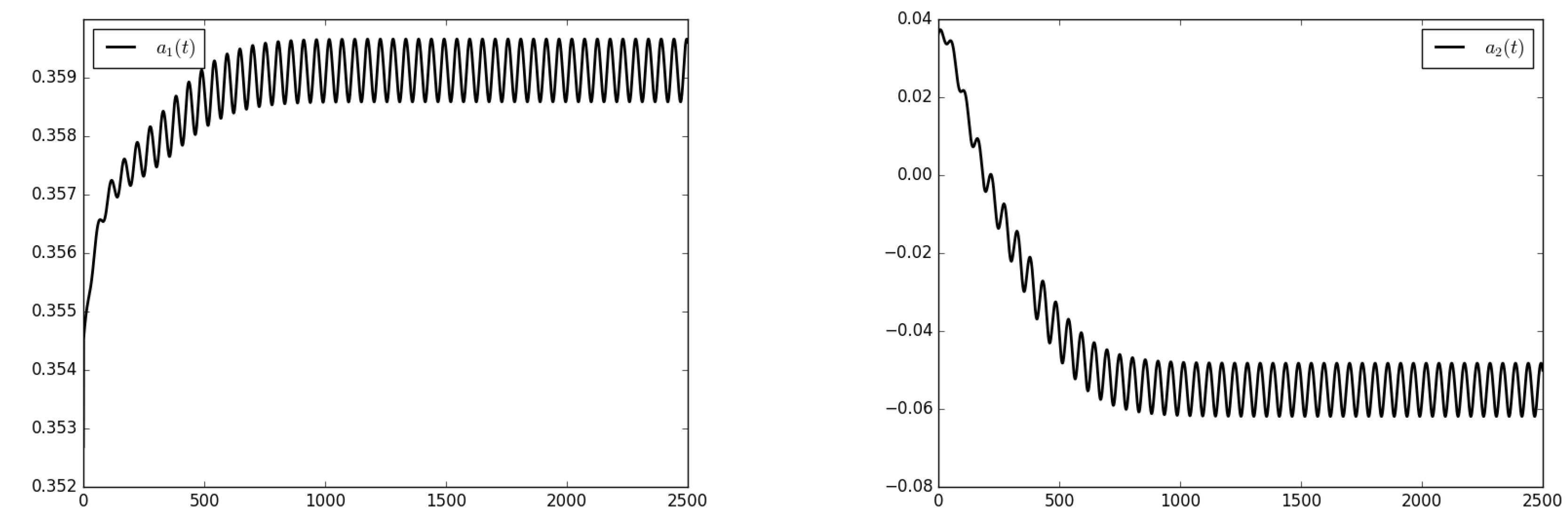




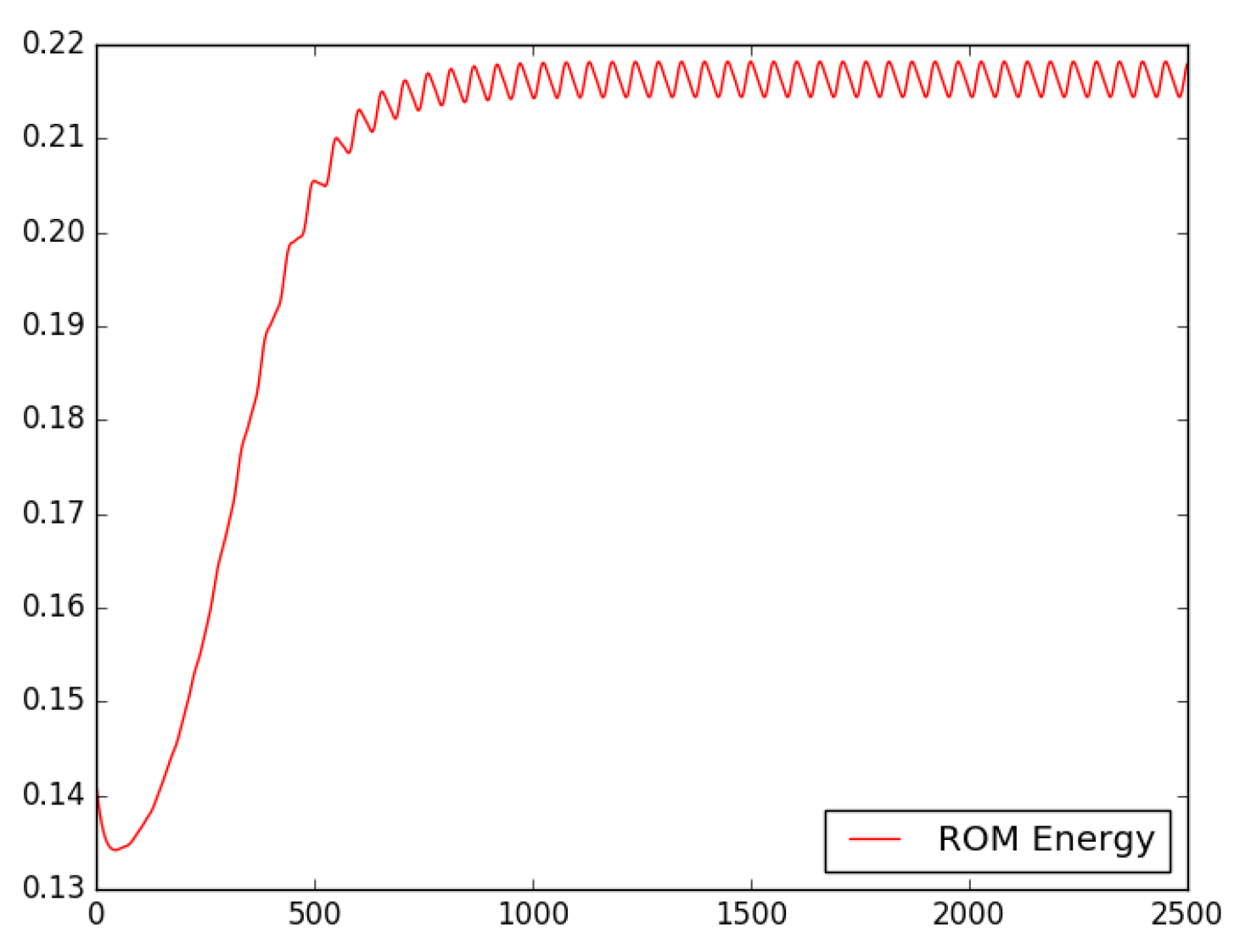
| Operation | Wall Clock Time |
|---|---|
| High-fidelity YALES2 solver (512 cores) | 5 days |
| Velocity-based POD + Disipative modes computation (768 cores) | 15 h |
| Stabilization by Gram–Schmidt (768 cores) | 3 h |
| Galerkin projection (768 cores) | 3 min |
| Time python ROM-POD solver (1 core) | s |
| Speed up factor |
© 2019 by the authors. Licensee MDPI, Basel, Switzerland. This article is an open access article distributed under the terms and conditions of the Creative Commons Attribution (CC BY) license (http://creativecommons.org/licenses/by/4.0/).
Share and Cite
Akkari, N.; Casenave, F.; Moureau, V. Time Stable Reduced Order Modeling by an Enhanced Reduced Order Basis of the Turbulent and Incompressible 3D Navier–Stokes Equations. Math. Comput. Appl. 2019, 24, 45. https://doi.org/10.3390/mca24020045
Akkari N, Casenave F, Moureau V. Time Stable Reduced Order Modeling by an Enhanced Reduced Order Basis of the Turbulent and Incompressible 3D Navier–Stokes Equations. Mathematical and Computational Applications. 2019; 24(2):45. https://doi.org/10.3390/mca24020045
Chicago/Turabian StyleAkkari, Nissrine, Fabien Casenave, and Vincent Moureau. 2019. "Time Stable Reduced Order Modeling by an Enhanced Reduced Order Basis of the Turbulent and Incompressible 3D Navier–Stokes Equations" Mathematical and Computational Applications 24, no. 2: 45. https://doi.org/10.3390/mca24020045
APA StyleAkkari, N., Casenave, F., & Moureau, V. (2019). Time Stable Reduced Order Modeling by an Enhanced Reduced Order Basis of the Turbulent and Incompressible 3D Navier–Stokes Equations. Mathematical and Computational Applications, 24(2), 45. https://doi.org/10.3390/mca24020045





